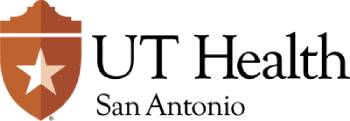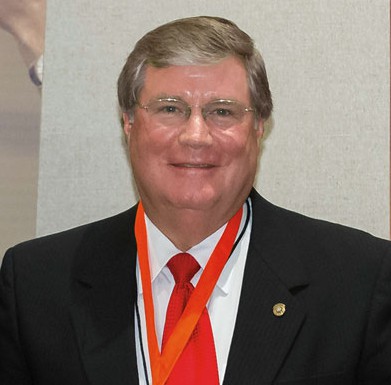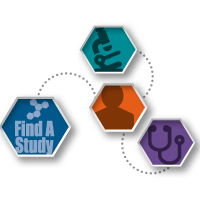Building a legacy
The Hinchey name is synonymous with health and service
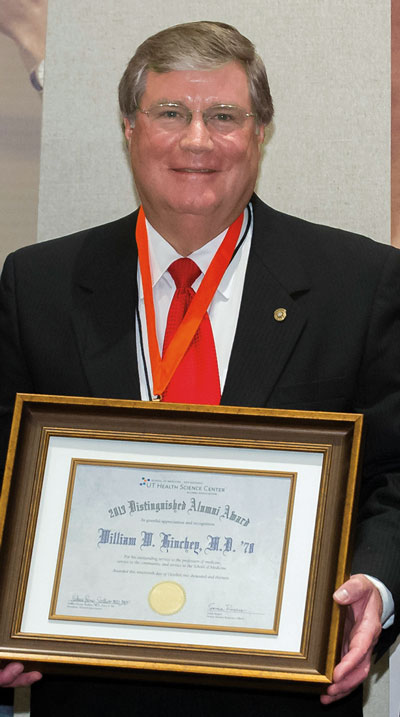
Family and service are at the heart of William Hinchey, M.D., class of ’78. With his father, John, and son, John, also practicing medicine and contributing both time and talent to community organizations, the Hinchey name is well known throughout Texas.
Dr. Hinchey is a partner with Pathology Associates of San Antonio and is the laboratory medical director for CHRISTUS Santa Rosa Hospital’s Westover Hills and Alamo Heights campuses. He also is an assistant clinical professor of pathology in the Long School of Medicine.
"While he has contributed through a variety of teaching and literary presentations, I feel that his greatest contribution to the profession is the willingness to sit at the head of the table," said classmate Michael W. Brennan, M.D., ’78.
Among his many hallmarks, Dr. Hinchey has served as president of the Texas Medical Association and in numerous roles with the Bexar County Medical Society and the San Antonio Medical Foundation Board of Trustees. He has also been a driving force among national and federal legislators by advocating appropriate funding of both medical and graduate medical education in Texas, prompt pay legislation, improvements to the Texas Medicaid program and other issues.
Medicine aside, Dr. Hinchey’s local community has benefited from his volunteer work. He has served with the Texas Cavaliers, the Order of the Alamo and St. Anthony de Padua Catholic Church.
Dr. Hinchey said his heart has never left the Health Science Center. He has actively participated in the School of Medicine’s Alumni Association since its formative years and has spearheaded reunions and activities for his class. In 2013, he was awarded the Distinguished Alumni Award in recognition for his service and dedication.
"It is so important to me to remain connected to the Long School of Medicine Alumni Association," said Dr. Hinchey. "It is a joy for me to give back to the Health Science Center that has given me and my family so much."
Following in his footsteps, his son, John Hinchey ’07, serves as a class agent for his fellow graduates.
"Like grandfather and father, this is an example of legacy," said Dr. Brennan. "Expect another Dr. Hinchey to follow."
For health and hope
First capital campaign exceeds goal and makes history
Every gift makes a difference
In 2004, the vision for the UT Health Science Center San Antonio included new homes for its medical and dental practices, a signature building for biomedical research, and endowments and program support to attract and retain the best faculty and students.
Simultaneously, the state was steadily reducing its appropriations to higher education and the National Institutes of Health was trimming grant support, making research funding even more competitive. It was a good time, officials believed, to launch the university’s first comprehensive capital campaign.
What followed over the next decade surpassed even the most optimistic goals and ignited the fuel that would propel the university forward.
The original goal for The Campaign for the Future of Health was $300 million to support the university’s missions of research, education, patient care and community service. The community responded.
"We had momentum and the mission drove us to expand our goal," said Health Science Center President William L. Henrich, M.D., MACP. "We reached for the stars, and set our sights on $500 million by Jan. 1, 2014."
From 2004 to 2014, 14,123 donors contributed 42,327 gifts to reach a final tally of $607 million.
"What we saw was how invested our community was in the future of health," Dr. Henrich said. "The byproduct of their efforts is hope, and the beneficiaries are our patients and students."
It was a $25 million lead gift from The Greehey Family Foundation that ignited the campaign. It allowed for the creation of the Greehey President’s Endowment for Excellence in Children’s Health Sciences, which supports cancer research and educational and community programs benefiting children, especially those in greatest need. As the campaign was coming to an end, the foundation announced its second gift—$5 million to establish the Greehey President’s Fund for faculty recruitment in medicine and dentistry, new endowments in pediatrics, and educational programs for students and faculty to provide patient care for those in need.
Today, the Health Science Center is home to the Greehey Children’s Cancer Research Institute and the Greehey Academic and Research Campus. The naming acknowledges the vital support from the Greehey Family Foundation, Dr. Henrich said.
"We needed a champion, and we found one in Bill Greehey," he said. "It’s only fitting that our campaign culminated with a major gift from him."
There were other standouts. In 2008, philanthropists Joe R. and Teresa Lozano Long established the largest endowment in university history. The $25 million gift established The Joe R. and Teresa L. Long Scholarship Research and Teaching Fund, an endowment that supports more than 50 students each year in medicine, nursing, graduate biosciences and physician assistant studies. It also supports endowments for faculty and research programs. The gift, which is one of the single largest cash gifts to an endowment in The University of Texas System, was recognized with the naming of the Joe R. and Teresa Lozano Long Campus at the Health Science Center.
The largest gift to the campaign was the Cancer Therapy & Research Center in 2007. The CTRC Foundation contributed an in-kind gift of CTRC facilities and equipment along with a cash gift of $24.5 million, and annual support, in perpetuity, from the CTRC Foundation endowment for the cancer program.
"The Health Science Center has earned its place as the chief catalyst for San Antonio’s $29.2 billion biosciences and health care industry," said Campaign Chair John T. Montford. "The UT Health Science Center continues to impact the city’s economy in a substantial way through the competitive jobs it creates and the biomedical research discoveries that ease suffering and improve health."
In one decade, in addition to donations and other funding raised through the campaign, the Health Science Center has secured $158 million in Permanent University Funds and $38 million in tuitionrevenue bonds for university projects. And its 2004 vision has been realized. The new facility for physician practice, UT Health San Antonio at the Medical Arts & Research Center, was opened in 2009. To attract exceptional biomedical scientists to San Antonio, the South Texas Research Facility was opened in 2011. And a new home for dental practice, the Center for Oral Health Care & Research, is expected to open in 2015.
Dr. Henrich said he is humbled by the community’s response, but "our work is not done."
"Although the path to deciphering some of our most vexing health challenges may seem daunting at times," he said, "it’s the spirit and support of our community that is the light that leads us on this uphill journey. We are San Antonio’s academic health science center, and our job is the future of health for this region and beyond."
Learn more about the Campaign for the Future of Health.
Coming home
UT System chancellor to return to HSC

After five years as the leader of one of the nation’s largest university systems, Francisco G. Cigarroa, M.D., is returning to the UT Health Science Center San Antonio.
The former Health Science Center president, who is chancellor of The University of Texas System, announced Feb. 10 that he will return full time to the Health Science Center as director of pediatric transplant surgery once a new chancellor is selected. He will be a member of the University Transplant Center, a partnership of the Health Science Center and University Health System.
During his 14 years as an executive-level administrator, Dr. Cigarroa continued taking surgical calls at least once a month at University Hospital.
"When initially approached by the Board of Regents to consider the chancellorship more than five years ago, I was inclined to say no, but I considered the similarities between health and education," Dr. Cigarroa said in a statement from Austin. "Like surgery, education saves lives on many levels, and I thought I could bring value to the UT System with that perspective in mind."
Highlights of his tenure in Austin include White House visits, the creation of an online dashboard of accountability by UT campuses and the establishment of two new medical schools for the state—the Long School of Medicine at UT Rio Grande Valley and the Dell Medical School at UT Austin. Dr. Cigarroa, a Laredo native, said the creation of the Valley medical school ranks among his proudest achievements.
"Dr. Francisco G. Cigarroa has made many impressive and lasting contributions as the chancellor of the UT System, and we are thrilled to have him back as a full-time pediatric transplant surgeon," said William L. Henrich, M.D., MACP, president of the Health Science Center. "This is a position in which he distinguished himself previously and from which he will continue to make lives better—one child and family at a time."
Sniff and scratch?
Environmental or chemical intolerance may be the culprit
 A headache after smelling strong perfume. Queasiness after sitting in a new car, surrounded by the aromas of fresh leather and carpet glue. Confusion after walking through vehicle exhaust fumes.
A headache after smelling strong perfume. Queasiness after sitting in a new car, surrounded by the aromas of fresh leather and carpet glue. Confusion after walking through vehicle exhaust fumes.
These could be signs of chemical or environmental intolerance, which affects about 20 percent of chronically ill patients, said Claudia S. Miller, M.D., M.S., an occupational and environmental health expert with UT Health San Antonio.
Everyday chemicals in the home, workplace or outdoors can trigger this intolerance, called Toxicant-Induced Loss of Tolerance. As common as the intolerances are, though, they rarely are diagnosed by physicians, Dr. Miller said.
In answer, she launched an online questionnaire called the Quick Environmental Exposure and Sensitivity Inventory, the only one of its kind validated in several countries and offered in multiple languages that comprehensively assesses symptom severity, severity of intolerances and life impact. Accessible for free on desktop computers and handheld devices at https://tiltresearch.org/, it generates a summary of the users’ responses that can be shared with their doctors to determine if they suffer from chemical and environmental intolerance and identify which substances are to blame.
"Patients who otherwise would suffer in silence can now measure whether chemical exposures contribute to their illnesses," Dr. Miller said.
The test screens for multiple chemical intolerances on four scales: symptom severity, chemical intolerances, other intolerances and life impact. Each scale contains 10 items, scored from zero to 10, to rank severity. There’s also a "masking index," which gauges ongoing exposures and overlapping symptoms that hide responses, blocking one’s awareness of their intolerances, and the intensity of their responses to exposures.
Online hub links patients, researchers and physicians
 Patients seeking treatments not yet available to the public have a new resource: the UT Health Science Center’s FindAStudy hub.
Patients seeking treatments not yet available to the public have a new resource: the UT Health Science Center’s FindAStudy hub.
The online tool, vpr.uthscsa.edu/findastudy, also provides information for physicians and researchers who need human study participants, and allows investigators to find research collaborators.
In bold colors at the top of the webpage are numbers that show how many research studies are being conducted by Health Science Center researchers and a running tally of how many categories are currently being investigated. The numbers are updated regularly, said Joseph Schmelz, Ph.D., RN, CIP, FAAN, assistant vice president for research operations at the Health Science Center.
"Since FindAStudy is linked to our Institutional Review Board database, it automatically posts our new IRB-approved human studies and then removes them when they are closed, so it is always up to date," said Dr. Schmelz.
There are categories related to aging and geriatric research; men’s, women’s and children’s health; diabetes; eye and dental diseases; nutrition; and studies for which healthy subjects are needed.
Martin Javors, Ph.D., a professor of psychiatry and pharmacology, conducts preclinical and human studies involving substance abuse. He found the new site helpful for finding subjects, he said.
"I received about 10 responses from healthy subjects for an ongoing study and a couple of inquiries for participating in a recently funded study to measure the level of a biological marker in the blood that reflects how much alcohol a person has consumed in the past few days," said Dr. Javors. "We hope to find some participants through FindAStudy."
The site also features links to clinicaltrials.gov, a registry and results database of publicly and privately supported human clinical studies, and researchmatch.org, a registry of human research studies offered by other academic institutions.
Mark Nijland, Ph.D., assistant vice president for research and associate professor in the Center for Pregnancy and Newborn Research in the Department of Obstetrics and Gynecology, was also the project leader of FindAStudy. The site will evolve over time, he said.
"We have a very robust search engine that will help users easily hone in on what they are seeking," said Dr. Nijland. "We are planning to continue improving the website over time."
Federal grant seeks to attract Hispanic students to dental careers
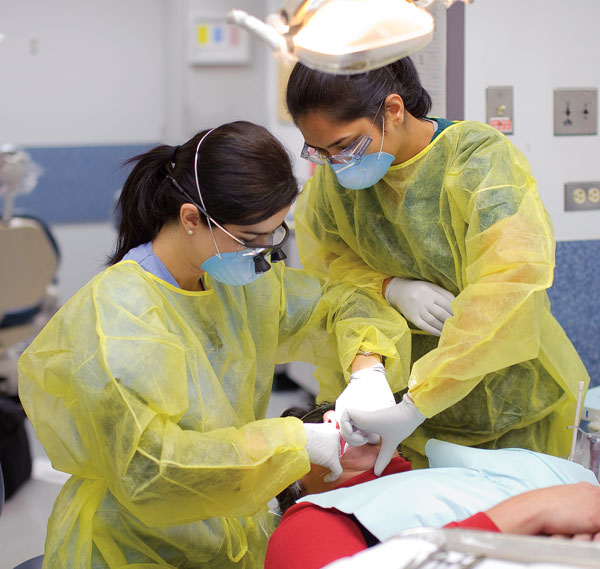 With a $2.7 million federal grant, the School of Dentistry at the UT Health Science Center is expanding access to culturally competent dental care in South Texas by attracting local Hispanic students to the profession.
With a $2.7 million federal grant, the School of Dentistry at the UT Health Science Center is expanding access to culturally competent dental care in South Texas by attracting local Hispanic students to the profession.
The Center of Excellence grant was awarded in July 2013 by the Health Resources and Services Administration, part of the U.S. Department of Health and Human Services. Investigators for the grant are Juanita Lozano-Pineda, D.D.S., M.P.H., and Jeff Hicks, D.D.S.
In addition to creating a pipeline of students from Laredo and the Rio Grande Valley heading toward dental careers, the four-year grant provides career development opportunities like fellowships and workshops for Hispanic faculty.
"I’m excited about reaching out to students from the Rio Grande Valley and Laredo areas, with hopes they become motivated to pursue a career in dentistry and someday deliver quality health care to patients in their communities," said Dr. Lozano-Pineda, a Brownsville native and Hispanic faculty fellow of a previous Hispanic Center of Excellence grant.
A primary objective is to increase opportunities for Hispanics to enter and successfully complete a dental academic program. Other goals include enriching dental student education, participating in community-based dental education and research, and emphasizing culturally competent dental care.
The School of Dentistry’s Hispanic Center of Excellence reaches out to high school, college and School of Dentistry students through recruitment, summer academic and leadership development programs, and faculty development training.
New dean selected for School of Health Professions

David Shelledy, Ph.D., who served as founding chair of the Department of Respiratory Care from 1994 to 2004, will rejoin the UT Health Science Center as dean of the School of Health Professions,. July 1.
Dr. Shelledy comes from Rush University-Rush University Medical Center in Chicago, where he is dean of the College of Health Sciences and professor of Health Systems Management.
Dr. Shelledy holds the Catherine and R. Winfield-Philip N. Jones, M.D. Professorship of University Affairs at Rush. He also has joint appointments in the departments of Clinical Sciences and Respiratory Care.
"We are happy to welcome Dr. Shelledy back to the Health Science Center. He did an outstanding job here as the founding chairman of our Department of Respiratory Care," said President William L. Henrich, M.D., MACP.
Atrium named in recognition of gift
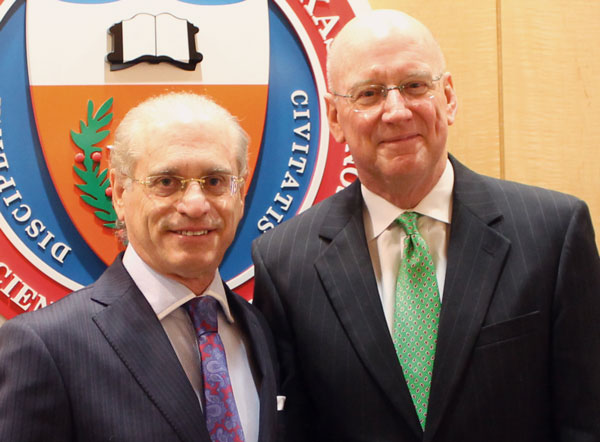
A $250,000 gift from Florida dentist Jeffrey P. Feingold, D.D.S., M.S.D., and his wife, Barbara, for the School of Dentistry and construction of the Center for Oral Health Care & Research will be recognized with the naming of a 1,510 square-foot atrium.
Located on the first floor of the Center for Oral Health Care & Research, The Dr. Jeffrey P. Feingold Atrium will be the public’s primary entrance. A plaque and portrait of the couple will be featured in the area.
"We are exceptionally honored by Dr. Feingold’s interest in the university and the School of Dentistry, and the association of his name will add prestige to our school and the Center for Oral Health Care & Research," said William L. Henrich, M.D., MACP, president of the Health Science Center.
Dr. Feingold is the founder, chairman and CEO of MCNA Insurance Co., the largest privately held dental insurance company in the country. MCNA, a leading administrator of dental benefits for Medicaid, Children’s Health Insurance Plan (CHIP) and Medicare programs, serves nearly 4 million members across the United States. The company’s regional office in San Antonio has over 300 employees that serve Medicaid and CHIP enrollees throughout Texas.
Dr. Feingold is a Diplomate of the American Board of Periodontology and has been a licensed Florida periodontist since 1971. While a resident at the Eastman Institute for Oral Health in Rochester, N.Y., Dr. Feingold was involved with developing clinical protocols for dental sealants in children. Today, he continues this focus on the prevention of tooth loss and early detection of tooth decay, and emphasizes the idea of total patient care.
"Dr. Feingold’s legacy will shape the future of dental education, research, patient care and community service for generations to come," Dr. Henrich said.
The Center for Oral Health Care & Research is expected to open July 2015.
Presidential praise

Health Science Center faculty and staff members who work hard to further the university’s missions of research, education, clinical care and service were recognized at the 2014 Presidential Awards ceremony in February.
This year’s highest Presidential Award, the Distinguished Scholar Award, was presented to Donald M. Dougherty, Ph.D., the William and Marguerite Wurzbach Distinguished Professor and deputy chair for research in the Department of Psychiatry, and professor in the Department of Pharmacology.
Dr. Dougherty’s translational research focuses on the various biological risk factors involved in drug abuse, drug dependence and suicide. Since joining the Health Science Center in 2007, Dr. Dougherty has accumulated nearly $20 million in funding, with the majority coming from the National Institutes of Health. He is principal investigator of five R-01 grants.
Award winners include:
Distinguished Scholar Award
• Donald M. Dougherty, Ph.D., Psychiatry and Pharmacology
Junior Research Scholar Award
• Michael Beckstead, Ph.D., Physiology
Teaching Excellence Awards
• Michelle Arandes, M.D., Pediatrics
• William P. Clarke, Ph.D., Pharmacology
• Lisa Cleveland, Ph.D., RN, PNP-BC, Family and Community Health Systems
• Kristin Fiebelkorn, M.D., Pathology
• Michaell Huber, D.D.S., Comprehensive Dentistry
• Diane Solomon, M.D., Neurology
• Kristine Vogel, Ph.D., Cellular and Structural Biology
• Earlanda Williams, Ph.D., Cellular and Structural Biology
Clinical Excellence Awards
• Cynthia Blanco, M.D., Pediatrics
• Autumn D. Clegg, M.S.O.T., OTR, Occupational Therapy
• Scott B. Johnson, M.D., FACS, FCCP, Cardiothoracic Surgery
• Anand B. Karnad, M.D., Hematology and Oncology
Employee Excellence in Service Awards
• Elizabeth Kay Eskew, Microbiology and Immunology
• Carol L. Kopplin, Legal Affairs
• Sarah Lindauer, Cellular and Structural Biology
• Rebecca Nixon, School of Dentistry’s Office of Continuing Dental Education
• Juan Reyna, RN, M.B.A., Regional Academic Health Center-Harlingen
President’s Choice Award
• Special Events Council
Appointments and awards
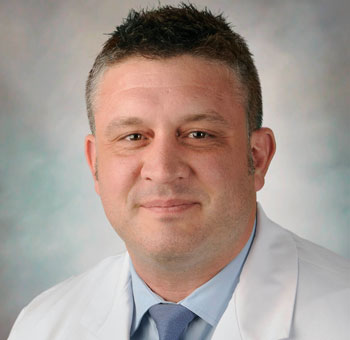
Ryan Bierle, PA-C, a specialist in emergency medicine, is one of only 108 certified physician assistants nationally to earn a specialty credential called a Certificate of Added Qualifications in Emergency Medicine from the National Commission on Certification of Physician Assistants. He is one of only 36 certified PAs in Texas and 530 PAs nationwide to earn the certificate since the program’s inception in 2011.
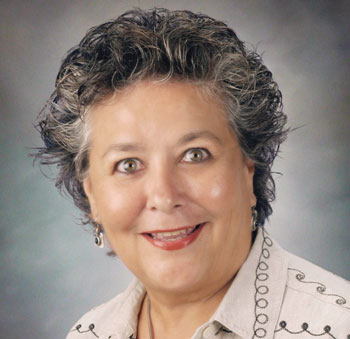
Norma Martinez Rogers, Ph.D., RN, FAAN, professor of nursing, has been appointed to a second three-year term as a commissioner for the Medicaid and CHIP Payment and Access Commission (MACPAC). Dr. Martinez Rogers was an inaugural member of MACPAC, which is a non-partisan federal agency charged with providing policy and data analysis to Congress on Medicaid and the Children’s Health Insurance Program. The commissioners make recommendations to Congress, the Secretary of the U.S. Department of Health and Human Services, and the states on a wide range of issues.
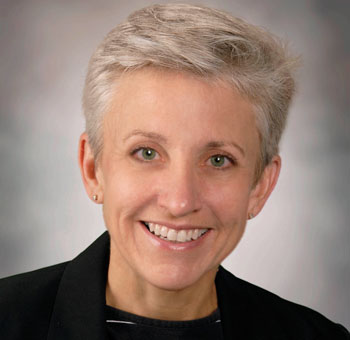
Stacey Young-McCaughan, Ph.D., RN,professor of psychiatry, was honored March 21 by the White House with its Women Veteran Leaders Champions of Change award. The award recognizes women who empower and inspire communities. Dr. Young-McCaughan serves as director of research for the STRONG STAR Consortium and the Consortium to Alleviate PTSD. The consortia together represent more than $100 million in research on post-traumatic stress disorder and related conditions, and are led by the UT Health Science Center San Antonio.
